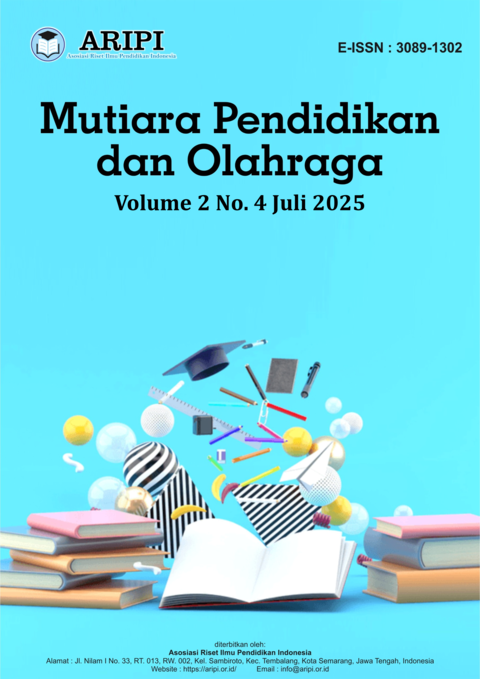Peran Orang Tua Atlet terhadap Prestasi Sepaktakraw Klub Cakrawangsa di Kabupaten Batang
DOI:
https://doi.org/10.61132/mupeno.v2i4.630Keywords:
Athlete Development, Family Support, Parental Role, Sepaktakraw, Sports AchievementAbstract
This study aims to describe the role of parents in supporting the achievements of sepak takraw athletes in Batang Regency. Athlete achievement is determined not only by individual abilities and training received, but also by support from their immediate environment, particularly family. In this context, parents play a strategic role in the coaching and development of young athletes, both physically, mentally, and emotionally. This study used a qualitative approach with data collection techniques such as in-depth interviews, direct observation, and documentation. The subjects in this study consisted of parents of sepak takraw athletes, athletes who have achieved success at the regional level, and coaches involved in coaching. Through this approach, comprehensive data was obtained regarding the forms of support provided by parents. The results show that parents play a crucial role in encouraging athlete success. This role is manifested through various forms of support, including moral support in the form of motivation and encouragement, material support such as providing training equipment and transportation costs, and direct involvement in monitoring children's development. Parents also actively communicate and collaborate with coaches and clubs to create a conducive coaching environment. In addition, parents' positive attitudes in appreciating their children's interests and talents contribute to the athletes' high level of self-confidence and commitment. Thus, active parental involvement has been shown to significantly contribute to improving the performance of sepak takraw athletes, particularly at the district level. This research suggests the need for systematic parental involvement in regional sports development programs.
References
(n.d.). Performance Journal, 1(2), 112–118.
(n.d.). Sport Sciences and Fitness, 4(4), 49–53.
[ATLET SEPAK TAKRAW JAWA TENGAH]. (n.d.). Journal of Physical Education, Health and Sport, 1(2).
[E-Biomedik]. (2015). E-Biomedik, 3(April).
[Jurnal Pendidikan Jasmani dan Olahraga]. (n.d.). Jurnal Pendidikan Jasmani dan Olahraga, 17(1), 46–53. [tanpa nama penulis dan tahun]
Aji, T. (2014). Peningkatan ketrampilan smash kendeng pada permainan sepak takraw siswa sekolah dasar.
Apriastuti. (2013a). Analisis tingkat pendidikan dan pola asuh orang tua dengan perkembangan anak usia 48-60 bulan di Desa Mudal Boyolali. Bidan Prada: Jurnal Publikasi Kebidanan Akbid YLPP Purwokerto, 4(1), 1–14. https://index.php/Prada/article/view/28
Aziz, A. R., Teo, E., Tan, B., & Qiuan, T. E. H. K. (2003). Sepaktakraw: A descriptive analysis of heart rate and blood lactate response and physiological profiles of elite players. 15(1), 1–10.
Beni, R. (2014). Survei motivasi masyarakat beraktifitas gerak olahraga menyongsong kebijakan Car Free Day. Journal of Physical Education, Sport, Health and Recreations, 3(6), 1142–1146.
Fitrianto, A. T., & Lubis, J. (2018). Model latihan penyerangan sepaktakraw. Multilateral: Jurnal Pendidikan Jasmani dan Olahraga, 17(1), https://doi.org/10.20527/multilateral.v17i1.5036
Hidayah, I. N., & Priyono, B. (2017). The development of "drilling" machine for sepak takraw practice. Journal of Physical Education, Sport, Health and Recreations, 6(3), 197–202.
Hidayat, A., & Indardi, N. (2015). Survei perkembangan olahraga rekreasi gateball di Kabupaten Semarang.
Hidayat, R., Sulaiman, & Hidayah, T. (2016). Faktor anthropometri, biomotor penentu keterampilan sepak takraw atlet putra PON Jawa Tengah. Journal of Physical Education and Sports, 5(2), 83–89. http://journal.unnes.ac.id/sju/index.php/jpes
Kerdsomnuk, P., Limroongreungrat, W., & Chaunchaiyakul, R. (2015). Ground reaction force and loading rate during sepaktakraw spike landings., 15(1), 1–8.
Maseleno, A., & Hasan, M. (2012). Fuzzy logic based analysis of the sepaktakraw games ball kicking with the respect of player arrangement. , May, 285–293.
Maseleno, A., Hasan, M., Muslihudin, M., & Susilowati, T. (2016). Finding.
Moch, A., Dhimas, D., & Dwi, P. (2016). Motivasi mahasiswa terhadap aktivitas olahraga pada sore hari di sekitar area Taman Sutera Universitas Negeri Semarang. 3(2), 113–120.
Palar, C. M., Wongkar, D., & Ticoalu, S. (2015). Manfaat latihan olahraga aerobik terhadap kebugaran fisik manusia. E-Biomedik, 3(1). https://doi.org/10.35790/ebm.3.1.2015.7127
Prativi, G. O., Soegiyanto, & Sutardji. (2013). Pengaruh aktivitas olahraga terhadap kebugaran jasmani. Journal of Sport. [volume dan halaman tidak disebut]
Purwaditia, A., & Suripto, A. (2017). Pengaruh metode latihan pliometrik terhadap power tekong pada atlet putri sepak takraw. Journal of Physical Education, Sport, Health and Recreations, 6(1).
Saputro, D. B., & Supriyadi. (2017). Pengembangan variasi latihan sepak sila sepak takraw untuk tingkat pemula. [kemungkinan Indonesia Sport Sciences and Fitness], 2(3), 32–36.
Sulaiman. (2014). Alat tes ketrampilan sepak takraw bagi
Downloads
Published
How to Cite
Issue
Section
License
Copyright (c) 2025 Mutiara Pendidikan dan Olahraga

This work is licensed under a Creative Commons Attribution-ShareAlike 4.0 International License.





